This piece has been updated, click here to view it.
The Museum of Fine Arts, Boston has found itself mired in controversy over an in-gallery program responding to Claude Monet’s La Japonaise, a portrait of the artist’s wife Camille clad in a kimono and posing with a fan. Replicas of the red kimono are available during free hours on Wednesday evenings through July for visitors to try on in the gallery, providing the opportunity to “channel your inner Camille #Monet.”
Unsurprisingly, the educational program/PR stunt has been met with negative reactions. A Facebook post by the museum announcing the photo opportunity drew dozens of comments by users who found the idea “vilely racist” and an example of “cultural appropriation at its finest.” A demonstration group, Stand Against Yellow-Face @ the MFA, is organizing in-gallery protests each Wednesday evening, with demonstrators carrying signage calling out the museum and the participating public for uncritically upholding traditions that diminish non-Western cultures and people to the level of props and stereotypes.
The painting in question, a work from 1876, is a singular example of Orientalism, a tradition in Western art that broadly caricatures regions as disparate as North Africa and East Asia with the aim of cultivating a Romantic visual language around Western cultural imperialism. Japonisme, the particular subset of Orientalism that Monet’s canvas depicts, is a loose interpretation of Japanese culture by French aesthetes marked by ornamentation, hyper-femininity and a sense of escapism bordering on pure fantasy. In La Japonaise the artificiality of the genre is underscored by the blonde wig Camille donned when posing for the painting in order to emphasize her whiteness, contrasting her body to the Otherness of her garments and surroundings.
Following the initial outcry, the museum produced a one-page handout responding to visitors’ concerns. Leading with an explanation of the Japanese origins of the replica kimonos (made for an exhibition on Orientalism in Western art at the MFA’s satellite museum in Nagoya), and the significant visibility of Japanese art and culture in the museum’s current exhibition offerings, the statement flatly lays out the museum’s position on the matter: “We don’t think this is racist.” The text goes on to define Japonisme and explain the painting as a commentary on the fad rather than a product of it. An official public statement has not yet been made available elsewhere, and it seems likely the museum would prefer the conversation to remain in the galleries and on social media, where it will quietly fizzle out.
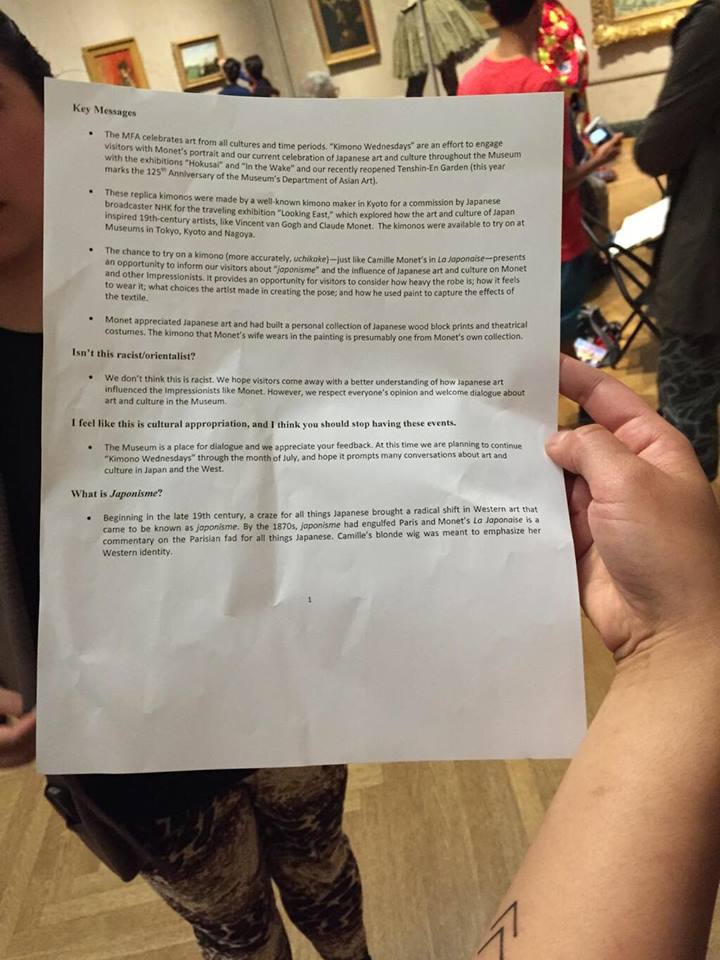
Image from Twitter user @diabola Amber Ying
The museum’s didactic text for La Japonaise emphasizes Monet’s awareness of Orientalism, presenting the painting as an ironic comment rather than a symptom. But if the argument is that the artist, and by extension participants in the museum’s Kimono Wednesdays photo-op, are “in on the joke,” that cultural appropriation is acceptable so long as it is served with a dose of irony, we risk giving a pass to anyone clever enough to winkingly acknowledge their prejudices while freely exercising them. This pervasive cultural tendency is no less destructive for its disarming effect. Perhaps Monet’s intention was to critique his country’s voracious appetite for a fantasy-ideal of Japan, but that entire line of thinking is erased by the museum’s approach. At best it is an uncritical way of engaging viewers with the work, and in the case of this particular painting, it does more harm than good.
As an encyclopedic museum, the MFA is charged with housing and displaying a cultural history shaped by dynamics of power, oppression, subjugation and bloodshed, dynamics that were largely racially justified. The very narratives of Western art history are laced with racist ideologies that live on today, and a major responsibility of art historical institutions in the twenty-first century is to acknowledge that subtext and teach it through objects. We can enjoy the beauty of things, we can enjoy ourselves in museums, but we also need to recognize the deeper implications of the cultural material on view. I have no doubts that the museum’s curatorial staff understand this charge. But when the responsibilities of dissemination and connection-building are handed over to Communications and PR specialists, that higher responsibility is too easily dismissed.
With one of the best departments of Japanese art in the United States, a sister museum in Japan, and cultural programs that bring Japanese artists, scholars and performers to Boston regularly, it’s surprising and disappointing that the museum didn’t create a more culturally sensitive learning experience, perhaps by inviting someone with more qualification than their College Ambassadors to handle the kimonos and explain their significance to the public, an effort that could have elevated the project beyond an offensive game of dress-up. That an idea like this could slip past the better judgments of so many shows not only how massive an institution the MFA is, but also how significant, how carefully considered every choice must be when tasked with the education of the public.
With the movement towards popularized museum experiences as a strategy of accessibility, we can expect to see a trend continue, wherein an object with a complicated history and fraught implications for the present will be reduced to a thing of spectacle at the expense of meaningful dialogue. The MFA should absolutely be pointing visitors to La Japonaise, but they should be asking why the image appeals to popular sensibilities, rather than simply celebrating it. They should be asking what this fascination says about our past as well as our current cultural condition.
It’s also worth considering why a kimono demonstration would be connected to Monet’s portrait of his wife, when the museum has any number of images of Japanese women donning the garment throughout their collection. If this were simply about an interest in the garment and its cultural context, the Japanese galleries would have made a far better site for such an experience. In the terrific Hokusai exhibition now on view, a painted hanging scroll by Katushika Oi, Hokusai’s daughter, features three women—a courtesan, a geisha and a townswoman—playing musical instruments together while wearing lavishly patterned kimonos. An image of three women from different social classes of 19th-century Japan—by an artist who is herself a Japanese woman—could provide visitors a meaningful entry into ideas around costume, embodiment and representation. The MFA’s choice to highlight a Western woman donning Japanese customs, and their encouragement of visitors to do the same, speaks to a different and far more problematic kind of embodiment.
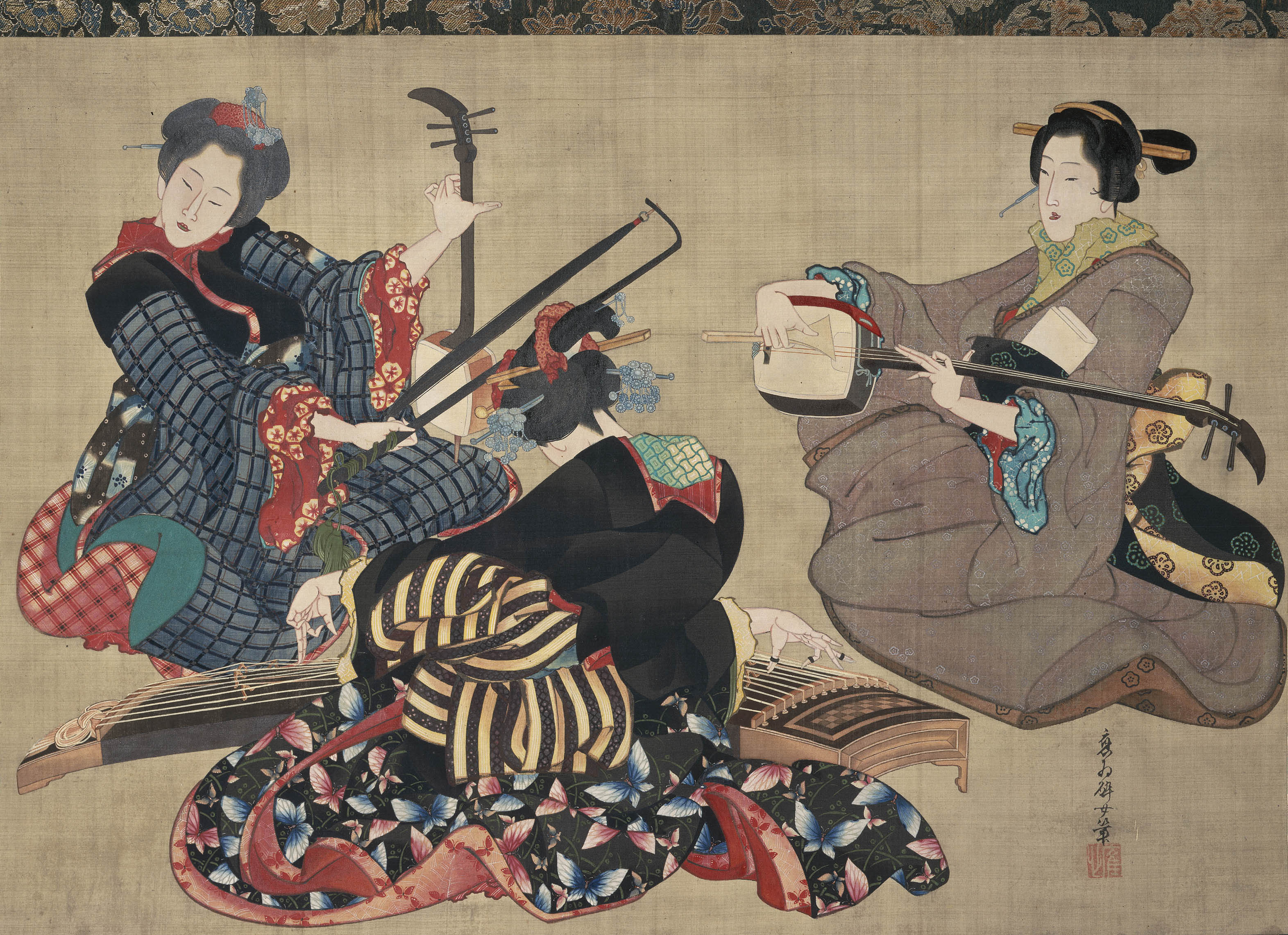
Gift cover (fukusa)
Katsushika Hokusai (Japanese, 1760–1849)
1844 (Koka 1)
Silk plain weave with ink and color
William Sturgis Bigelow Collection
Photograph © Museum of Fine Arts, Boston
Conversely, many other examples of Orientalism, cultural appropriation, and racist caricaturing can be found on display in the museum, and while their role as objects of beauty or entertainment have dissipated with the maturation of cultural consciousness, their value as tools to understand the lens of Western thought and bias are invaluable. La Japonaise continues its life as an uninterrogated object of beauty at the expense of an important lesson.
In August, the museum will open an exhibition on the influence of Asian art on the colonial Americas, displaying works created in the Americas as facsimiles of trade goods imported from Asia. The exhibition may provide an opportunity to see how the complex network of cultural exchange and exploitation that defined the Age of Colonization was visualized and represented in objects, and how completely its evidence permeated everyday life then, just as it does now. With any luck the complexity of that story will be handled with a bit more care as it is passed on to museum audiences.
Kimono Wednesdays are scheduled to take place every Wednesday evening through July in the Impressionist galleries during the museum’s free admission hours. Public protests are scheduled to coincide for the duration of the program.
UPDATE 7/7/2015 4:27PM: The Museum of Fine Arts Boston has reached out to us with the following statement regarding their in-gallery programming, and have posted it on their website:
The MFA’s mission is to engage people with direct encounters with works of art, and to be an inclusive and welcoming place for all. When the MFA’s painting, La Japonaise by Claude Monet, travelled throughout Japan for an exhibition, historically accurate reproduction kimonos were made for visitors to try on. When the painting returned to Boston and a similar program was introduced at the MFA, we heard concerns from some members of our community, and as a result we’ve decided to change our programming. The kimonos will now be on display in the Impressionist gallery every Wednesday evening in July for visitors to touch and engage with, but not to try on. This allows the MFA to continue to achieve the program’s goal of offering an interactive experience with the kimonos—understanding their weight and size, and appreciating the embroidery, material, and narrative composition. We will also increase the number of Spotlight Talks presented by MFA educators, to take place every Wednesday evening in July in conjunction with the display of the kimonos. The talks provide context on French Impressionism, “japonisme,” and the historical background of the painting, as well as an opportunity to engage in culturally sensitive discourse. We apologize for offending any visitors, and welcome everyone to participate in these programs on Wednesday evenings, when Museum admission is free. We look forward to continuing the Museum’s long-standing dialogue about the art, culture and influence of Japan.
- Content from Twitter user @diabola Amber Ying
- Image and comment thread from the Museum of Fine Arts Boston Facebook page, post dated June 19, 2015.
- Image from Twitter user @diabola Amber Ying
- Gift cover (fukusa) Katsushika Hokusai (Japanese, 1760–1849) 1844 (Koka 1) Silk plain weave with ink and color William Sturgis Bigelow Collection Photograph © Museum of Fine Arts, Boston
- Content from Twitter user @diabola Amber Ying

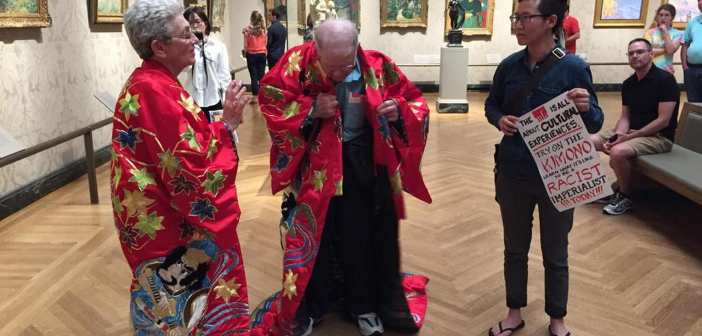
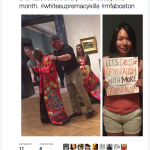
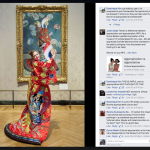

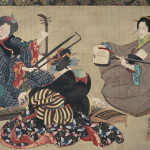
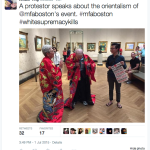



61 Comments
I have been following this story and waiting for a response that does not dismiss the protesters’ concerns (as the museum’s vulgar handout does). MFA Boston should know that a wall text is worth a thousand pictures. This inane gallery activity could be turned into a productive conversation if only museums could be places for discourse and dissent rather than chauvinism and censorship.
Listen people. When it comes to hybridity: Cultural Imperialism = appropriation, Interculturalism/Cosmopolitanism = cultural exchange, Transculturation = convergence
This is a case of intercultural dialogue NOT appropriation!
Pingback: Outrage at Boston Museum of Fine Arts—artnet News
Pingback: Outrage at Museum of Fine Arts Boston over Disgraceful “Dress Up in a Kimono" Event | ART
Just toss out the Monet. Burn it, shred it, whatever. Problem solved.
Burn…a…Monet!…
Alright no. just no. Do you know who Monet is? He is the Father of Impressionism. One of the fore runners to the collapse of the Salon system. He is up there with some of the great masters of art.
And trust me some people will not even think twice about destroying you if you so much as touch the thing. That is of course if you are not imprisoned for destroying a valuable painting.
Turner is the father of impressionism
Good idea: burn anything we don’t like. Erase history, erase art, and turn off your brain in the interest of the politically correct.
The MFA’s response to the racist ramifications of their in-gallery program involving the ill-conceived kimono caricature is the same lame response we get from the Washington Redskins regarding their use of a term that is highly offensive to Native Americans. It’s not enough to say “it’s not racist because we don’t mean it that way.” The MFA Boston should known better. Apologize, drop the “program” (gimmick), learn from it.
The MFA Boston program is not ill-conceived and it is not a caricature. You don’t know what you’re talking about and you have not done your homework on the sociocultural political issues involved here. You should apologize because you are the racist here. You think of the Japanese as some culture that needs saving from you. How condescending is that.
Trying on, or touching a kimono is not racism. The kimono is probably the epitome of textile art, and should be appreciated by anyone who with an interest in textiles or Japanese culture. It is amazing to me that most of the protesters are not even Japanese, yet they have appointed themselves protectors of Japanese culture. I am white, but have spent much of my life in Japan. As a child, we wore traditional garb during holidays and for school pictures. Yet a Chinese-American who likely has never even been to Japan is going to tell me and the rest of us what is and is not respectful handling of a kimono. The consensus I have heard from actual Japanese about this issue is that a kimono is not awarded for bravery or earned during a secret Japanese ritual. They are purchased at a department store. Like shoes or a hat.
This seems like political correctness gone daffy! Here in Japan, the only people buying kimonos are tourists! Kimono dyers and weavers are going out of business at an alarming pace. If only the Japanese would renew their interest in their native dress… until then, the interest foreigners have in the kimono is a large percentage of the market. I think the Japanese would be surprised that this is program is even a bit controversial… Just walk down Nakamise in the Asakusa area of Tokyo, and you will find store owners even a little pushy to get one to try on their kimonos. Or on a walk down the street in Kyoto, and if you see someone in a kimono, there is an 80% chance that person is a foreigner who has availed him or herself of one of the many ‘rent-a-kimono’ services that have become especially popular there in the last few years.
I personally believe this was an interesting effort on the part of the museum to engage the patrons. I would be very surprised to see a Japanese person genuinely offended by this. As a Japanese acquaintance points out, it it probably more in the realm of bad taste than bad manners. (the Japanese generally prefer more subtle, understated colors; this particular kimono is in the style of the ‘Oiran’ courtesan.)
In the era of the selfie, it is an excellent way to encourage visitor participation.
Sorry, Mr. West. Unfortunately, you don’t get to speak on behalf of Japanese people and say how you think they might react like. In fact, it doesn’t even matter how they might react. It doesn’t change the fact that what’s going on is an extremely distasteful example of orientalism. An “excellent” way to encourage visitor participation – at the cost of miseducating one group of people and demeaning another.
Also, there are big differences in the attitudes of those whose livelihoods depend on the selling or renting of kimonos and those who don’t. People have to eat, man.
Mr. Xu,
Just who DOES get to speak on behalf of Japanese people? Certainly not you, Xu. Your statement that it doesn’t matter how the Japanese would react is quite presumptuous.
The umbrage displayed by the protesters is an agenda-driven contrivance wrapped-up here in a garland of florid academic jargon. Much ado about nothing, perhaps, but sadly it was enough to cow a weak MFA into submission.
Self-righteous dudgeon wins the day. Hooray, MFA.
Racism in Japan is real and far worse than this.
Also what right do you have as non-Japanese defending Japanese?
Yes you’re part of the bland group of white-washed “Asian Americans” but does that give you representative right?
Thank you! I totally agree!
Oh man, sorry, I’m Japanese-American (Nikkei or Nisei, if you prefer) and, yeah, I’m kind of with Mr. West with putting this in the class of Yankees going to the South and buying cowboy boots and/or hats and looking like idiots. (Or Southerners going North and going to the “Cheers” bar.) I mean, like with the Meiji Restoration (which was about the same time as Monet was painting, I suppose), the Japanese can be pretty flexible about appropriation (Or even in modern times – I mean, why is KFC a Christmas food?) Of course, I can’t speak for the Japanese people, but neither can you, I suppose.
I guess I wonder who nominated Xu Zeming to “speak on behalf of Japanese people”.
One of the pernicious effects of Orientalism was/has been a tendency to lump together all the peoples of Asia in one “oriental” basket, no?
Those of us “white” people who live in Asia find the North American “princess and the pea” obsession with these kinds of “racism/cultural appropriation” issues rather silly.
I suggest you all wake up and look around at all the folks around the world appropriating “western culture” in all its myriad forms and who won’t even let “foreigners” rent apartments never mind control what and how local museums are curated.
Well you don’t get to speak on behalf of japanese people either, so why are you so angry about what other people enjoy and that so far, a majority of japanese don’t seems to care about.
Using buzzword like ‘orientalism” or trying to take some sort of moral highground and trying to “educate” people, doesn’t make you right.
You’ll find another 1st world problem crusade to fight on, cos that’s what the perpetual offended always do, mob on buzz campaign, and forget it all the next week.
All things considered, I’m not sure you have the right to speak for Japanese as well, seeing as you have a Chinese name.
The relations and views of China and Japan are very negative towards each other already, especially due to issues such as Japan’s unwillingness to admit to their war crimes in China, the Senkaku Islands, and other issues. A quick check shows that 90% of Chinese view Japan negatively, and the feeling is mutual, as 70% in Japan view China negatively.
Whether Japan is in the wrong or not, I don’t get the feeling that they would appreciate Chinese fighting their battles for them, no matter if it offends them or not. I would say that once things settle down regarding those issues then maybe the Chinese should be able to decide what Japan feels about their clothes and traditions. Though having been surrounded by Japanese culture for a significant amount of time I have a feeling that I know what the answer would be.
By your logic, the Brits and the Japanese have been wrongfully appropriating Indian curries after spices were introduced to them, that means they now shouldn’t partake in these foods.
So-called righteous folk like you expect others to understand people of different race, and when they try on a foreign hairstyle, lifestyle, food, clothing, way of life as a token of respect and an effort to understand a culture more, you start blurting out a this no nonsense, hipster term.
Maybe you should look in the mirror, what you’re doing is nothing more than promoting ignorance.
Have you read Said? Do you even know what orientalism is? Since you are the expert, why don’t you give me some bullet points on how this is orientalism. Make your argument.
Good point. I’ve read Said, and not even Said seems able to define Orientalism. But it seems to be an effectively frightening epithet.
Said defines Orientalism as “A collective notion identifying “us” Europeans as against all “those” non-Europeans, and indeed it can be argued that the major component in European culture is precisely what made that culture hegemonic both in and outside Europe: the idea of European identity as a superior one in comparison with all the non-European peoples and cultures.
There are Westerners, and there are Orientals. The former dominate; the latter must be dominated, which usually means having their land occupied, their internal affairs rigidly controlled, their blood and treasure put at the disposal of one or another Western power.”
So how by wearing the dress of “others” we somehow “dominate” them? exploit them? This to me is more an example of interculturalism/cosomopolitanism – having curiosity towards others, or even transculturalism – converging upon, encompassing, becoming bicultural, than imperialist orientalism.
Someone briefly wearing a kimono during their visit to a museum is not cultural appropriation.
I want to say as Japanese, I and my friends wounder why such a protest happen. Protestants names are not Japanese name, I wounder why not Japanese people protest to say “it’s racist event”.
Anyway, Kimono is still special for us, we wear Kimono at a ceremony, in the other hand Kimonos are sold as souvenirs. It’s business. As you mention, the style of this picture’s lady is ‘Oiran’ courtesan, but I love this picture. This picture is one of the most famous picture of the Impressionists in Japan. We proud that our culture influence such a beautiful art.
So, I afraid that US people think such a event let Japanese ill feeling. We are happy MFA exhibit a lot of Japanese art and let Bostonian know our culture. At least Japanese art, I believe they are purchased collect way. Please enjoy!
Thank you for your kind words.
I really think too many have too much time on their hands…therefore, ruffling feathers and being ruffled seem to feed the need.
I’m sorry, but I really do agree with the museum on this one. There’s nothing inherently racist about this. Even still, teenage girls from the Western United States are engulfed by various anime, and go around in kimonos and what not, mostly because of their fascination for the subject and no one complains about that. I guess I just don’t really see what the big deal is.~
Wow these guys sure have a lot of time on their hands. I wish the museum had just ignored them and left them to their hug box so they could feel oppressed somewhere esle.
Totally agree! Thank you!
Wow. Yeah. Only racist artists appropriate other cultures. I mean, could you imagine the furor if a Takashi Murakami, say appropriated the iconography of a famously French, I don’t know luggage company, for his art? What kind of racists museums would continue to show the artist after that?
Pingback: Doing Ironic Irony Ironically: Play-Acting Satires of Orientalist Japonisme? | Frog in a Well
I just love Identity politics. Doesn’t everyone get a kick out of identity politics?
i love it, because it makes everyone feel so good and is so productive!
Well said.
Pingback: This just in… #solarenergy, Bernie Sanders and socialism, #yellowface at the #MFA, and more. | wellhellobetty
God this is imbecilic beyond belief. So now the simple act of wearing the clothing of another culture is racist. We’ve jumped the shark, gone over the rainbow, through the looking glass, etc. I’m so sick of people who make a life out of being offended by everything. Ignore the spittle flying from the lips of these haters and let cultures continue to mingle and intermix. That’s how we learn about each other and grow as a society. What these radicals are advocating is nothing less than total cultural segregation based on ethnicity and skin color. So who are the racists, exactly?
Thank you I totally agree!!!
This is yet another attack on intercultural learning. Mr. Smith is only versed in the discourse of cultural imperialism with its sub-frameworks of orientalism, and colonialism. It’s a very old argument that focused on appropriation – that is, stealing, or taking something without permission to use in a context not intended. Mr. Smith, you are not aware of the discourses of intercultural learning, intercultural dialogue, cosmopolitan ethic – that is, a curiosity towards otherness, and you are not aware of transculturalism – that is, a convergence of cultures. You sir, represent the worst of multiculturalism – that is, separate but equal treatment of cultures. You have no idea what culture is. Culture my friend, is not static. People do not live in boxes. Why don’t you ask the Japanese what they think about this museum showing? Why do you feel the need to be the culture police? Stop it! We are all global citizens learning from one another. Stop trying to make everybody into a victim. The great nation of Japan will not be destroyed by what this museum is doing. Educate yourself on other frameworks with which to view POSITIVE EGALITARIAN CULTURAL EXCHANGE. You are blinding by our PC cultural that ONLY see appropriation.
This is the stupidest thing I have read in a while. How is appreciating the costumes of another culture racist?
Like the controversy with the confederate flag remove the painting.
No Joseph this is not like the confederate flag. People wanting to learn about other cultures does equate to racism.
Sorry. I mean, This does NOT equate to racism.
So, non-Asians cannot try on kimono as that is “cultural appropriation”. Someone better let the makeup studios here in Kyoto know, they’re doing booming business dressing up non-Japanese in Kimono, with full Maiko make-up in the case of the ladies, and then turn them loose to wander around town. Granted, watching a large westerner attempt to walk in a proper Kimono for the first time is rather amusing, but no one takes offence.
I wore Hakama and Haori at my wedding, as did several of my non-ethnically-Japanese friends, none of our in-laws (or spouses) took offence.
If I am to be take offence at a westerner trying on a Kimono at an art museum in Boston, shouldn’t I also take offence at the Chinese folks in jeans, shorts, tank tops and flip-flops who are pictured above protesting? Are not they guilty of “cultural appropriation” by dressing in Western clothes?
Kimono is culture . Anti-Japanese = Racism does not forgive .
Dear Nityonityo, I am not sure what you are writing, but I invite you to debate me on this. Please speak in complete sentences. Thank you.
You should look up a video about this by Japanese youtubers Rachel and Jun about this subject, as it shows how the Japanese actually view the problem with it. Focus on racial issues is far more of a Western mindset than it is in Japan. Most Japanese are interested and want to have foreigners partake in their culture, and push for them to try on kimono if/when they can.
Pingback: Standing Against Yellowface @ The MFA: “Kimono Wednesdays” Cancelled | asians art museum's samurai blog
1. I doubt a kid in Shibuya is being criticized for wearing chuck Taylor’s and a ramones tshirt
2. When monet’s japonisme toured Japan they had a kimono wearing activity that was tacky but wildly popular
3. Japanese government’s initiative “cool Japan” officially sanctions and promotes events like these, not to demean or appropriate but to generate interest and awareness.
4. Incredibly elitist to think the only authentic intercultural interaction is by spending thousands of dollars to visit Japan or years earning a post graduate degree in East Asian studies. Some people want to experience a slice of Japanese culture and this provides that.
5. This instance of identity politics is counter productive, shallow, albeit a fun exercise of Internet yelling.
Thank you for speaking up! I totally agree with you!
Hi. My comment is long but I can assure anyone that it is worth the read if you are at all interested in what Japanese in Japan have to say about this.
I am quite speechless after reading this very extensive article. So the Boston Museum has been forced into cancelling a programme in which visitors could don replicas of the Kimono depicted in Monet’s La Japonaise and take photographs in front of it. This is sad.
As a Japanese born citizen and kimono fanatic, my view is that the best way to gain any sort of understanding about kimonos and the rich culture surrounding them is to actually try them on. They’re garments for goodness sake, where else are you supposed to start?
All this talk about the programme being vilely racist leaves me exasperated. The better half of Japanese know barely anything about kimonos, and plenty of Japanese go to Kyoto each year to play the exact dress-up that the article condemns so vigorously. Tonnes of foreign tourists -of all ethnicities- do the same, and I have never heard of any Japanese complaining about being racially offended by that. Dressing up in kimonos and taking photographs just for the fun of it is also a fad in Shanghai at the moment, and Japanese kimono makers I know are thrilled at the the new business chance overseas.
So what is the right way to go about the whole thing? I think that the Museum should keep on with it’s renewed programme and also let visitors try the kimono on.
The hyper-sensitive outbreak is something I cannot understand at all. I am rather happy that the Museum thought of such a programme that would give non-Japanese visitors a chance to feel the kimonos’ weight on their shoulders, which is an experience you could not easily have elsewhere. All these protesters have done is to deprive visitors of such an experience that might actually make people more interested in further understanding of the garnment and it’s history.
I also have to add that the demonstrator on twitter may be oriental but isn’t even Japanese and should have no reason to be upset by the programme about La Japonaise. The same can be said of a few commentators here who I assume are also oriental but are definitely not of Japanese descent. I am a half New Zealander but my father who is pure Japanese has condemned the whole matter as being utterly idiotic, and has the opinion that the Museum never should have surrendered to these invalid and hysteric reactions. Many Japanese friends have also said the same.
I must point out that the pseudo-oriental lettering used to write the word KIMONO on the placard held by the male protester in the photograph is a billion times more racist and stereotypical, ignorant and culturally offensive if you ask me. That’s the sort of thing that really irritates me, not people having fun learning about something that they’re wearing for the first time.
Pingback: Boston Kimono Alarms Culture Crusaders
Now that the news has spread in Japanese, many people here in Japan are now discussing this episode of appropriation gone crazy.
I have already expressed my views as a holder of qualifications on Kimono studies from the Japanese Kimono Promotion Association, and many of my peers and Professors from Tokyo Univ. Of Arts which I attend are expressing their shock towards the nonsensical outbreak against the Museum’s original programme. Researchers and people here in the kimono industry all say that they are very disappointed about the Museum’s decision to not allow people to try the Kimono on any more. I haven’t heard a single complaint about the original programme being inappropriate, distasteful or racially offensive come from any Japanese. So who has the right to whine about appropriation now?
I really have to say that these protests are just so self righteous, counterproductive and offensive in themselves. Very, VERY frustrating-on behalf of the Japanese society.
I agree
Comment from Japan:
Is it nothing to do with Japanese?
If not, I’d say it may be a kind of obsessive-compulsive disorder of the society. I believe 99% of Japanese feel embarrassed not by the cancellation itself but by the fact that US society misunderstands the mind of Japanese.
Pingback: Cultural Approbation vs. Cultural Appreciation & MFA’s Kimono Wednesday | Denver Sewing Collective
I checked out the last name Said in my school library. There are several. Which one(s) are you saying people should read?
I’m sorry, but this campaign shows a poor understanding of history, of colonial and postcolonial theory, of the place of Japan in imperialist politics and of modern Japanese attitudes towards racism and similar issues.
Japan was never colonised. It was never even under consideration for colonisation. In fact, it ended up colonising other places, and was encouraged to do so by western powers until the 1930s. Indeed, Japan attracted a lot of admiration at tue turn of the century in particular, when it was defeating China and Russia. Japanologists have being saying for the past 30 years that Saidian Orientalism is a poor approach to understanding the west’s relationship to Japan. Yet here we see the same old academic cliches being spouted in order to manufacture faux-outrage about an event which just isn’t that controversial, and which is being promoted by Japanese organisations.
Cultural “appropriation”, or cultural exchange, to put it in normal parlance, is what all ethnic groups do, and have always done, and it is not necessarily either oppressive or demeaning. If we didn’t borrow from other cultures we’d all be sitting in caves unable to read or write. Japan has appropriated plenty from Europe. That’s what human groups do.
I find it ironical that the author of this piece recommends, as an alternative to the Monet piece and as a representative of Japanese kimono art, a picture which purports to be of a geisha, a courtesan and a townswoman, because the geisha/courtesan stereotype really was problematic in the 19th century, and which caused a lot of misery for women at the time. There is plenty of kimono art that has nothing to do with geisha or courtesans.
As an a academic, I’m dismayed that cultural theory is so poorly understood, and that it is being used to bully well-meaning, liberal institutions into capitulating to an extreme agenda. And I get the feeling that people are bandying around jargon without really understanding it.
I totally agree with you. I am a composer and my dissertation is on the subject of frameworks of intercultural music. I am also dismayed and frustrated that too many ethnomusicologists turn by default to the framework of appropriation, exploitation, resistance, and cultural imperialism. I am making the case for an alternate framework that involves working class cosmopolitanism, interculturalism, borrowing, reciprocal exchange, and so on. Can I quote you for my dissertation?
Hi David,
Yes, please feel free to quote me. I’ll contact you via your website with the titles of some publications.